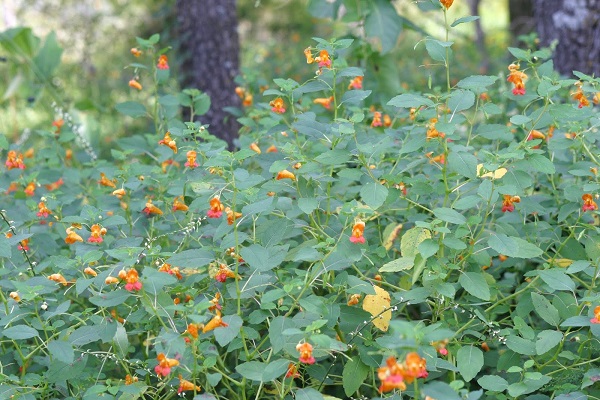
Jewel Weed is the Nearatic species of genus impatiens. The parts that grow above the ground are used to make medicine. Be careful not to confuse jewel weed with potentilla, since both are known as silverweed. Jewel weed is a smooth annual that grows three to five feet tall with trumpet shaped flowers that hang from the plant like a jewel from a necklace.
Jewel weed blooms from May until October in eastern North America from southern Canada to northern Florida. It is found in moist woods and creek banks frequently near poison ivy and stinging nettle. However, just because there is poison ivy or stinging nettle, you won’t necessarily find jewel weed. It will not grow in dry places or thrive in direct sunlight while the other two plants will. If you do not have access to wild jewel weed, there are garden varieties of impatiens that have the same properties (but not as concentrated as the wild varieties).
Medicinal Uses
Jewel Weed is said to aid digestion and increase the loss of body water through the urine (diuretic effect), but there isn’t scientific information to back these claims. Some people apply juices of jewel weed directly to the skin for the treatment of poison ivy and its juice helps relieve bee and wasp stings. However it does not always cure them completely. In addition, it helps sooth the irritations of nettle stings, minor burns, cuts, eczema, acne, sores and other skin irritations. It is also good to for warts, bruises, and fungal skin infections such as athlete’s food and ringworm.
The best known medicinal use for jewel weed is in the treatment of poison ivy. Apply jewel weed juice to an area on the body that has been in contact with poison ivy to prevent rashes from the poison ivy from appearing. It not only works to help prevent a rash, but also works in the treatment of an existing poison ivy rash.
Poison Ivy Rash Symptoms
- Itchy skin where the plant touched your skin
- Red streaks or general redness where the plant brushed against the skin
- Small bumps or larger raised areas
- Blisters filled with fluid that may leak out
Poison Ivy Rash Treatment
A study in 1958 found that impatien biflora was effective alternative medication for skin irritation caused by contact with sumac. Later studies, however, did not give the same antipruritic affects after the rash appeared. These conflicting studies were reviewed and it was discovered that the method used to prepare and the typing of application determined the effects of the jewel weed against the poison ivy. According to a subsequent study done in 2012, an extract made from the orange jewel weed was not as effective as a topical application of the crushed stems and leaves to the affected area.
If you have already developed the rash, break the stem of the jewel weed and rub it on the rash until you draw some blood. The rash will dry out, a scab will form and healing will take place often within a couple of days.
Jewel Weed Tincture
Although jewel weed often grows where poison ivy grows, it is not always found where poison ivy is found. If you find a source for jewel weed pick the fresh plants and store them in a sealed container in the refrigerator. They will last up to one week.
Prepare a tincture by soaking fresh jewel weed in commercial witch hazel for a few weeks. The extract of the two herbs preserves well and it will last for several months. If witch hazel is used in the preparation, this tincture should only be used externally.
Jewel Weed Ointment
Ointment can be made by simmering a small amount of jewel weed in light vegetable oil (but not olive oil because olive oil will burn) for 10-15 minutes. Use only a small handful of the stems per quart of oil; if too much is used, juice will form on the surface of the ointment and in a few days will turn moldy. To thicken the oil, strain the herb from the oil and add beeswax. Heat it until the beeswax has melted and remove a spoonful at a time to cool and test thickness. Add more oil or beeswax if needed. Add one capsule of oil soluble vitamin E (as a natural preservative). Let the mixture cool and refrigerate it where it will last for several months.
Donna Brown is the author of the gardening book Simply Vegetable Gardening which is available on her website: Cygnetbrow.com.
Related Articles & Free Email Newsletter
Dried Herbs Require Little Work and Offer a Great Reward




Comment here